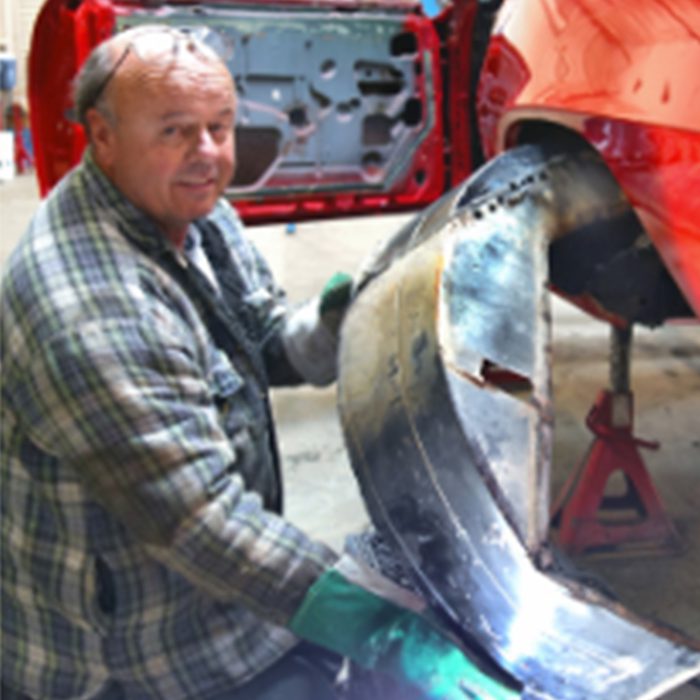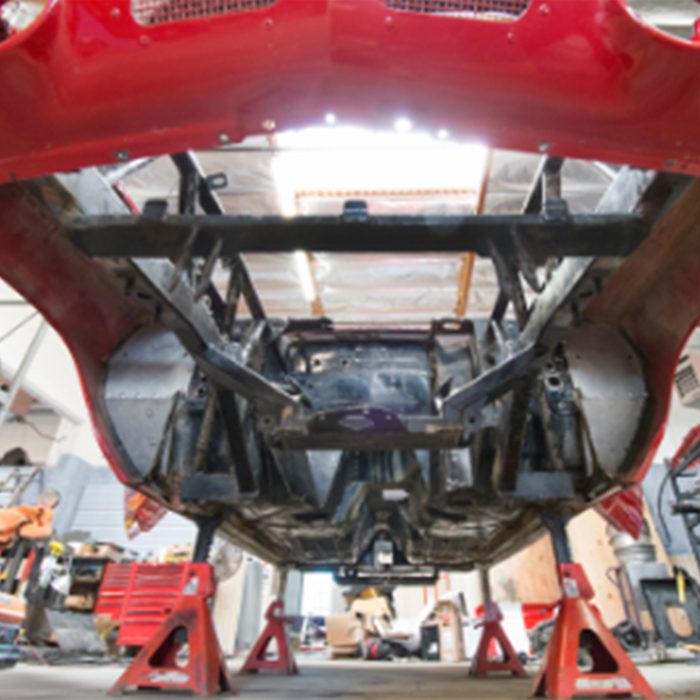Tear Down

Big Red’s time has come. It looked great in the sunset on the first official evening of the tear down. Big Red had never been through a complete rebuild, down to the last nut and bolt. In 2004, it went through an invasive restoration, but nothing like this complete rebuild. As nice as it looks in the first few rebuild photos, it’s on the surface. As you look through the next few pages, you’ll get a better idea of why Big Red was slated for a complete rebuild.
The first parts to be removed were the cowl panel and exhaust pipes. The rebuild process officially had started. It was a big project, but the team had been waiting for this moment for years. Big Red is a race car, so function is always more important than form. Over the years, the car had evolved from a single-purpose road-race car to the baddest multipurpose’69 Camaro ever built. Big Red just came off its latestrecord run of 251.8 mph, SEMA 2015, and a cameo appearance in Dax Shepard’s movie, CHiPs. The Land Speed/Top Speed engine, nicknamed The Elephant (because of the trunk-like supercharger intake pipe), is the most complicated setup, and it will get a complete overhaul. Like a four-star general’s jacket, Big Red’s windshield is wearing its medals. From left to right, Dave, Josh, and Tim talk about the filming timeline with the progress that’s expected during the rebuild.
Big Red’s interior slowly has been evolving since 1988. Many changes and additions have been made as new types of racing have been added to Big Red’s list of different speed attempts
The interior had become busy with wires and components. Even with some of them tucked away, it’s obviously a race car. The dry-sump oil hoses travel into the cabin from the engine over the wheel tub toward the trunk. On the opposite side of the car, there were fuel hoses going over the passenger side wheel tub as well. The team wanted to move all the fluid hoses out of the cockpit. The original aluminum interior side panels are taped with high-speed racing tape to keep out the dust at El Mirage. Pretty much everything under the car was painted black and could use some freshening. Two electric Stewart pumps were used to push water from the 55-gallon tank (which doubles as a fuel tank for Road-Race mode) to the Land Speed/Top Speed powerplant during high- speed passes. The light-colored dirt stuck to the old black paint under the car is leftover silt from El Mirage. The diagonal suspension link is easily identified as the locator bar for Land Speed/Top Speed. The Road-Race version (shown elsewhere in the book) is strengthened by additional bracing. Most of the rear suspension will stay, but with few upgrades. As some of the components were removed from the interior, the chipped and worn black paint was more visible. The center gauge console and switch control panel ahead of the shifter were slated for permanent removal. The pedals and steering column were on the chopping block, too. A lot of changes were on the way inside the car.


The interior sheetmetal is all original, built by Bill Osborne in 1987-88. All of the panels are getting replaced, starting with the wheel tubs. Tim happily removed the old wheel tub to make way for all-new aluminum panels to replace the steel panels. The spindles, hubs, and control arms will be inspected and refreshed as necessary. The old QA1 shocks did their fair share of work over the years at road races, hill climbs, salt flats, dry lakes, and more. They are going to be replaced with some new Penske Racing shocks. Big Red will receive all new wires from the headlights to the taillights, so all the legacy patches, splices, and temporary fixes (that became semi-permanent) have been removed. The stock gauge cluster had been cracked for a while, and has served its time. The AutoMeter tachometer and Stewart Warner gauges ultimately will be replaced with new versions from the same brands. More parts kept piling up on the shelves. They ultimately will be organized, but in the interest of getting the car stripped, the parts came off faster than expected. Apart from the body panels, all of the bolt-on parts have been removed.
With all the parts removed, it’s hard to tell that this is Big Red. Without the dashboard, it’s even tough to recognize that this is a ’69 Camaro. The transmission tunnel, firewall, and interior sheetmetal will be cut out, trimmed back, and modified. The cage will get some changes to improve ingress and egress, as well as increased safety. The factory floorpans will remain in place. They are part of the reason so many people like Big Red. It’s an actual 1969 Camaro.
It has a factory-issued VIN that proves it was originally built by Chevrolet in 1969. A handful of so-called ’69 Camaros have attained big speeds that rival Big Red’s, but those are carbon-fiber Camaros that never rolled off the Chevrolet assembly line. Keeping the original floorpans and steel fenders are key ingredients to keeping it a true, original Camaro. The doors, front fenders, lower valance, and header panel were kept in place because they already were aligned. Dave is going to replace the reproduction driver’s side front fender and header panel with different OEM pieces. He knows the parts are currently aligned, and that will help him with the process of modifying the front fender to fit existing panels. The chassis is in for some small changes. Big Red’s shelves in the corner of Dave’s shop were overflowing with racing parts. Every part here, going back on the car, will be rebuilt and refinished prior to re-installation. All other parts will be retired for display in the future Big Red museum.
